BC's aging recreation facilities put healthy communities at risk.
A report released by BCRPA stated that as of 2008, 68% of the province's recreation infrastructure was at least 25 years old and in urgent need of funding for renovation or replacement.
Findings:
The BCRPA's - A Time for Renewal: Assessing the State of Recreation Facilities in British Columbia- took stock of the condition of BC’s recreation infrastructure. Based upon 5 years of comprehensive research, study and analysis, the report highlights that $5.2 billion (in 2008 dollars) is needed over the next decade to upgrade and replace the province's aging indoor recreational facilities. BC's aging infrastructure is unable to keep up with the demands of a growing population that has changing needs and is reaching the crisis point on funding requirements.
Access the reports below.
Actions:
The BCRPA set out to make recreation infrastructure renewal a top priority and continues to work with decision makers at all levels to gain their support and commitment in making this issue a public policy priority. Join us in our campaign to turn a pressing need into a public policy priority.
A Time For Renewal: An Assessment of British Columbia's Recreation Facilities
To be the 'Best Place on Earth', British Columbia must be the healthiest community on earth. Just as healthy living requires a new focus and on-going commitment, recreation infrastructure urgently needs a steady on-going investment. With sustainable maintenance and renewal funding, recreation facilities are one of the most cost-effective prescriptions for good health and engaged citizens.
“The need for a sustainable recreation infrastructure funding strategy has never been greater, and the BCRPA Recreation Facilities Assessment Study has provided a solid evidence base for the development of such a strategy. This report consolidates the research and makes a clear case for action by the province of BC and its municipalities.”
– DON HUNTER, PRINCIPAL, DON HUNTER CONSULTING
| Reports |
|
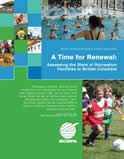 |
Executive Summary
A Time for Renewal: Assessing the State of Recreation Facilities in British Columbia
This 12-page executive summary provides a brief overview of the findings outlined in the full report: A Time for Renewal: Assessing the State of Recreation Facilities in British Columbia.
Download the Executive Summary Report
|
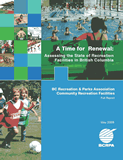 |
Full Report
A Time for Renewal: Assessing the State of Recreation Facilities in British Columbia
A Time for Renewal is intended to communicate the key findings of BCRPA’s research to date on the status of BC’s recreation facilities and discuss the implications portrayed by the data. This document examines why our recreation facilities are important to the people of BC and builds a valid case, supported by empirical data, for the thoughtful, immediate and on-going renewal of our recreation infrastructure.
Download the Full Report
|
|
Background Reports
|
|
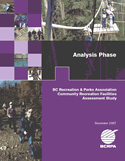 |
Analysis Phase
BC Recreation & Parks Association Community Recreation Facilities Assessment Study
The scope of Analysis Phase of the study was to analyze the eight types of indoor and four types of outdoor recreation infrastructure gathered in the three inventory phases of
the study. The Analysis phase provides insights into the age, distribution and quality of our recreation assets and preliminary estimates of BC’s growing facility infrastructure deficit.
Download the Analysis Phase Report
|
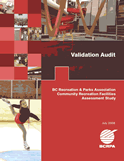 |
Validation Audit
In April 2008, the British Columbia Recreation & Parks Association commissioned detailed assessments of a sample of existing recreation facilities in the Lower Mainland Region. The primary purposes of the assessments were to validate the theoretical assumptions about the condition of the recreation facilities made in the Analysis Phase.
Download the Validation Audit Report
|
 |
Phase 1: Inventory
Ice Arenas, Indoor Pools, Outdoor Pools, & Curling Facilities
During the spring of 2003, The British Columbia Recreation and Parks Association commissioned the production of an inventory, in the form of a database, of Ice Arenas,
Indoor Pools, Outdoor Pools, and Curling Facilities owned and/or operated by local municipalities in BC.
Download the Inventory Phase 1 Report
|
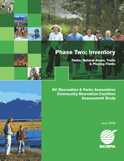 |
Phase 2: Inventory
Parks, Natural Areas, Trails & Playing Fields
During the winter of 2004, The British Columbia Recreation and Parks Association commissioned the production of an inventory, in the form of a database, of Parks, Natural Areas, Trails and Playing Fields owned and/or operated by local municipalities in BC.
Download the Inventory Phase 2 Report
|
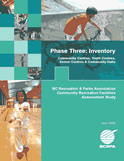 |
Phase 3: Inventory
Community Centres, Youth Centres, Senior Centres & Community Halls
During the winter of 2005, The British Columbia Recreation and Parks Association commissioned an inventory, in the form of a database, of Community Centres, Youth Centres, Senior Centres, and Community Halls owned and/or operated by local municipalities.
Download the Inventory Phase 3 Report
|
Contact:
Communications Department
What is the State of Recreation Infrastructure in BC?
Few people today can dispute the benefits that recreation has on our quality of life. Recreation is essential to our well-being, encouraging physical activity, fostering social connections and providing enjoyment for all ages and abilities.
But what about the places we use for swimming, skating, walking and playing? Are they capable of supporting BC’s growing population and the changing face of recreation?
A Time for Renewal
Our parks, pools, arenas and community centres – BC’s recreation infrastructure – form the hearts of our communities. These are places where people gather for neighbourhood celebrations, where we cheer local sports heroes and where we go to learn new skills and take part in physical activity. Because our recreation, sport and leisure facilities are so important, yet so little was known about their condition, BCRPA launched a Community Recreation Facilities Assessment Study to take stock of these assets and evaluate their condition. This was the first detailed study of its kind in BC. The goal was to develop a clear picture of the state of our aging recreation infrastructure and what needs to be done to keep it a vital part of our communities for coming generations.
The Facilities Assessment Study examined eight types of indoor and four types of outdoor publicly owned and/or operated recreation facilities. The data generated revealed a clear picture of the escalating challenges our communities face related to sustaining and improving our recreation facilities.
The Facilities Assessment Study included three key components:
- Inventory Phases: Three inventories were performed to compile a comprehensive database of existing recreation facilities in BC.
- Analysis Phase: An analysis study examined the inventory data and developed theoretical infrastructure replacement and rehabilitation costs.
- Validation Audit: 34 existing recreation buildings were selected for detailed evaluation and audit to validate the theoretical analysis and establish empirical data about facility rehabilitation needs and costs.
What Did the Assessment Study Find?
Our recreation buildings are rapidly aging.
68% of BC’s indoor recreation facilities are 25 years or older.*
42% of BC’s indoor recreation facilities are 35 years or older.*
The Inventory and Analysis Phases used five “life-cycle stages” based on building age to evaluate the condition of BC’s recreation facilities. Although many factors contribute to the long-term viability of a facility, life-cycle provides a standard scale by which to measure and compare the state of our facilities. The Validation Audit confirmed that the majority of recreation facilities studied exhibited physical conditions consistent with age.
Typically, as a facility’s life-cycle stage increases, operational costs and the need for capital upgrades escalate dramatically, while energy efficiency and functionality decline.
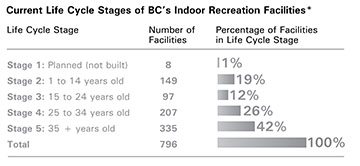
Click to Enlarge
Our population continues to grow.
In the next ten years, BC Stats population predictions suggest that 575,900 or 13% more people will be living in BC. By 2035 we could have over 6 million residents. An obvious disparity exists: Our population is increasing rapidly while our recreation infrastructure is declining just as quickly.

Click to Enlarge
Our older buildings don’t match our new lifestyles.
Wear and tear is not the only problem a building faces as it ages. Functional obsolescence, which is a loss in utility due to changing demand from its users, affects older buildings that can’t be retrofitted to accommodate new uses. Functional obsolescence can impair the utility of a facility and diminish public support of existing recreation assets.
Our investments have been inconsistent.
Inconsistent funding has led to uneven investment periods for recreation infrastructure. The late 1960s and the 1970s saw a surge in recreation infrastructure funding and the result was the development of an essential base of facilities that have been serving our communities for over 30 years. The investment surge was followed by a decline in spending on recreation. This scenario has generated a deficit in which a large number of our recreation buildings are now nearing the end of their useful life spans and require extensive renovation or complete replacement.
Our recent investment hasn’t kept up.
By looking at capital investment in indoor recreation infrastructure over time, we can see that our recent investment has not kept up. In the 1970s, our per person investment in recreation infrastructure was almost three times the per person investment of the 1990s. Our lack of recent investment in recreation facilities is contrary to our rising awareness that recreation and physical activity are vital to our everyday lives.
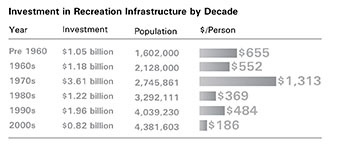
Click to Enlarge
The results of the Facilities Assessment Study show that investment in BC’s recreation facilities is now critical. As many of our facilities reach the end of their life spans, reinvestment is needed. This time, however, we call for more than a large, one-time investment.
It is time for long-term renewal that ensures a sustainable, ongoing future for our recreation facilities.
*Facility age statistics are taken from the Facility Assessment Study Analysis Phase completed in 2007. Today these numbers would be higher.
Active people lead healthier lives and have stronger connections to their communities. A powerful case exists that investment in recreation infrastructure is a preventative approach to health and social well-being that offsets spending on reactive infrastructure such as hospitals and jails.
So why should we be investing in recreation?
For Healthy Active People
Participation in physical activity and recreation is a key determinant of health status and is known to: reduce risk of heart disease and stroke, help prevent certain types of cancers, help combat type 2 diabetes, reduce occurrence of youth and adult obesity and help reduce incidence of fall-related injuries and chronic conditions in older adults. Activity can also foster social opportunities and contribute to mental health by reducing stress, combatting depression and building emotional well-being.
For Social Engagement
Recreation builds stronger individuals and families by reducing negative, self-destructive behaviours such as smoking, substance abuse and juvenile delinquency. This positive approach helps reduce social service and justice costs. Recreation has the ability to break down cultural, class and identity barriers, improving the quality of life for all British Columbians.
For Community Spirit
Recreation engages people and builds social cohesion, generating healthy, inclusive communities. People feel an emotional connection to the places that bring them enjoyment, making our recreation nodes truly a heart within our communities.
For Environmental Responsibility
Recreation goes hand in hand with environmental protection. Parks and natural areas protect habitat, improve air quality and clean water resources. Active people seek opportunities to incorporate exercise and recreation into their daily lives, often choosing to walk and cycle rather than drive. It is time to ensure our recreation infrastructure supports our environmental commitment by providing energy-efficient, green places for us to play.
For the Economy
Investment in recreation infrastructure offsets reactive investments in health and social justice infrastructure. Parks, trails and recreation facilities increase property values and tax revenue. Recreation facilities generate construction and operations job opportunities and support tourism, providing venues for everything from high-performance sporting events to recreational attractions.
Society today is not the same as it was 50 years ago. Our interests, leisure time and activity choices have changed. We cannot expect facilities built 50 years ago to support our new lifestyles and so we must think clearly about our recreation needs today and for the future.
What trends must we consider?
Our Activity Choices
In today’s hectic society, people tend to choose less structured activities that fit easily into varied schedules and changing routines. We are pursuing a greater diversity of activities and are looking for ways to incorporate lifestyle and wellness into our daily routines. These shifts impact the size and layout of facilities, facility operating schedules and demand for outdoor recreation.
Our Shifting Demographics & Diversity
As we age, our preference and capacity to participate in recreation changes, affecting the services we require. Additionally, cultural diversity presents a need to ensure that all residents of a community have access to relevant recreational experiences. Finally, due to changing economics, commercial enterprise and personal preference, some communities grow while others decline. By anticipating these population shifts we can invest in our recreation facilities where our dollars will have the greatest benefit.
Our Approach to Recreation
Today we recognize the value of integrating multiple recreation levels and services in one facility. This integrated approach combines overall building costs while extensively increasing the utility, accessibility and operational benefits of a single facility. These multi-use facilities quickly become community hubs, but also require extensive planning and often large capital investments.
Our Desire to be Inclusive
Recreation is an essential right for all British Columbians, however many facilities are not yet capable of providing full access to everyone. Over a quarter of our indoor and almost half of our outdoor recreation facilities in BC rate as poor in terms of physical accessibility. While accessibility varies by activity type and site conditions, a significant number of facilities in BC require upgrades in order to provide barrier-free access to all.
Our Environmental Awareness
As concern for the environment grows, people are supporting protection of green space through parks, open spaces and trails. Public stewardship is gaining momentum and new technologies allow development of public infrastructure with a much smaller carbon footprint, increasing the viability of and need for green decision-making.
A strong case exists for the important role recreation facilities play in our communities. The BCRPA Facilities Assessment Study has undertaken a critical next step by completing preliminary cost analysis to determine the level of investment needed for renewal of BC’s recreation facilities.
How much do we need to invest in recreation infrastructure?
The work done through the Analysis Phase and Validation Audit of the Facilities Assessment Study developed and verified preliminary cost analyses for the recreation infrastructure deficit.
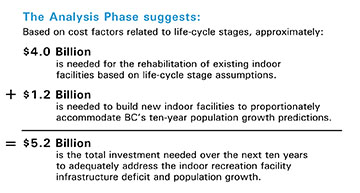
Click to Enlarge
The Validation Audit suggests:
Most of the 34 buildings studied in the Validation Audit exhibited physical conditions consistent with their age. There were some older facilities, however, that had retained their physical vitality through upgrades and renovations; there were also a few younger facilities that suffered from premature failure of physical systems and general building deterioration. By completing further empirical studies of existing facilities, more accurate renewal costs could be established and extrapolated province-wide.
What about our outdoor spaces?
Studies to date have focused on our indoor recreation deficit. Outdoor spaces play an equal role in providing recreation opportunities and improving quality of life. The aging of our outdoor spaces is reflected in degraded playing fields, unused playgrounds and deteriorating trails. Land development puts pressure on the space available for outdoor recreation areas and trail connections. This is compounded by our growing population, increasing the need to accommodate more users where less green space is available. While budget numbers for outdoor spaces are typically smaller than indoor spaces, the benefits of investment in outdoor recreation are proportionately large. Renewal programs should balance both indoor and outdoor recreation investments.
"Even though many external conditions and internal factors come into play, there is no better time than now to renew our recreation infrastructure.”
– Gary Houg, Manager, Maintenance & Engineering Services, North Vancouver Recreation Commission
With more than 68% of our recreation infrastructure over 25 years old and an over $4 billion deficit, we are now at a critical crossroads. It is time to turn away from one-time short sighted investments to a life-cycle approach to recreation infrastructure.
A New Approach to Recreation Infrastructure
The BCRPA is suggesting a new approach to partnership programs for recreation infrastructure funding – one that supports life-cycle management. Three program components are envisioned:
- Recreation Renewal Program: An on-going capital fund for indoor and outdoor recreation projects, both major and minor.
- Recreation Partnership Planning Program: A component to encourage co-operative and efficient program delivery.
- Recreation Life-Cycle Program: A new program to promote life-cycle information sharing and preventative action.
Each proposed program may include funding from local, provincial and federal governments, although the proportion of funding may vary among program components.
Current infrastructure programs are focused on rejuvenating the economy in the short term. In addition to this stimulus, we recommend that recreation infrastructure funding programs be designed for the long-term to provide sustainable funding and avoid a ‘once in 30-year wave of investment’ scenario that leads to recurring recreation deficits.
Recreation Renewal Program
The Recreational Renewal Program would utilize a similar arrangement to existing federal, provincial and local shared funding agreements. However, refinements to the program funding would change project delivery to include additional partnership and life-cycle approaches.
Funded project planning should include, in addition to the funding priorities defined on Page 11 of this report, a detailed life-cycle maintenance and operations plan that:
- Sets out approximate timing and budgets for on-going maintenance; and
- Establishes the expected longevity and replacement costs of all major facility components.
A recommended element for the Recreation Renewal Program is a central, standardized web-based data system that compiles capital, operating and maintenance cost reporting from new or renewed facilities, so that a province-wide database on recreation facility life-cycle planning can be maintained.
“Keeping up is not just a matter of replacing aging facilities. It is a commitment to family and community life that lies at the very core of the society we cherish.”
– Kevin Pike, Former Director of Parks & Community Services, District of West Vancouver
Recreation Partnership Planning Program
Use of recreation and sport facilities often transcends municipal boundaries and recreational interests. Funding construction and operation of such facilities is best accomplished through partnerships among neighbouring jurisdictions, private interests and/or non-governmental organizations, with assistance from senior governments. To ensure funding opportunities are explored and effective partnerships are formed, we propose a Recreation Partnership Planning Program to provide a pool of funds to:
- Promote co-operative facility planning among adjacent municipal and regional governments, with a goal to maximize benefits and inclusivity and avoid facility redundancy;
- Seek opportunities for private and/or NGO partnerships for capital and operational funding;
- Fund studies to analyze the demand for both high-performance sport facilities and recreational facilities to achieve an appropriate gradation of services throughout the province;
- Support production of preliminary designs and accurate cost estimates for capital, maintenance and life-cycle planning; and
- Support partnership organization and fund-raising efforts.
Recreation Life-Cycle Program
When facility maintenance and upgrades occur when needed, a facility’s lifespan increases dramatically. Competing demands for municipal operating finances has often left gaps in local funding for maintenance. These difficult funding situations can lead to premature obsolescence or unsafe facilities, translating into requests to senior governments for replacement funding. To avoid premature facility failure, we propose a joint Recreation Life-Cycle Program to:
- Support development of a province-wide database on typical life-cycle best management practices, needs and associated budget requirements;
- Complete and maintain a province-wide database on existing recreation facilities;
- Provide on-going training to maintenance and operations personnel on appropriate life-cycle maintenance practices;
- Publish print and web-based information in support of life-cycle maintenance and renewal practices; and
- Develop challenge grants for on-going life-cycle maintenance, to encourage identified ‘preventative maintenance or greening initiative’ projects that extend a facility’s usefulness and efficiency and/or lower its operating expenses.
The Recreation Renewal Program and its component programs should be sustained at an adequate level to address the recreation deficit and required new capacity over a 20-year period. Once the recreation deficit is erased, on-going funding should be steady-state to provide on-going life-cycle renewal and increased capacity in step with population change.
“The renewal of park and recreational facility infrastructure across the province will be a huge undertaking: the resulting benefits in terms of health and social cohesion will be equally enormous.”
– Mark Vulliamy, Manager of Planning & Research, Vancouver Park Board
As we plan our investments in recreation infrastructure, we need to ensure recreation funding is strategic and based on priorities. The following principles should guide the evaluation of potential recreation facility projects.
- Distribute projects equitably throughout the province using region- and province-wide planning to reduce facility redundancy and gaps and maximize benefits.
- Encourage partnerships between adjacent municipalities, private organizations, NGOs or other agencies.
- Design projects to anticipate and respond to current and future recreation needs and trends.
- Target strategic outcomes that can be measured and reported.
- Balance investment in indoor recreation and sport facilities with improvements and additions to outdoor spaces.
- Create facilities that are multi-purpose and flexible, integrating sport and recreation and allowing for adaptation to meet changing programming trends.
- Develop effective life-cycle maintenance programs and educate personnel to successfully perform these programs.
- Encourage well-planned, multi-year initiatives that support effective facility planning.
- Set high environmental standards for new recreation infrastructure and seek opportunities to retrofit existing infrastructure to reduce recreation’s carbon footprint.
- Engage recreation organizations, sport communities and key industry stakeholders when making decisions about the future of recreation facilities.
- Assess the capacity of municipalities to take on the maintenance, operations and rehabilitation funding required for new recreation facilities.
- Choose inclusive projects that target all segments of a community.
- Seek opportunities that address economic, health and social outcomes.
- Coordinate projects to contribute to community renewal.
- Support creative design and use of up-to-date construction techniques.
- Compliment and respond to existing federal, provincial and local recreation related initiatives.